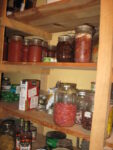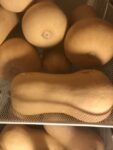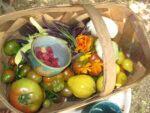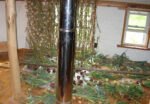A version of this column first ran in the Roane County (WV) Reporter and Times Record. Support local journalism! Subscribe to your local newspaper. This is one of a series of blogs for new gardeners. Start reading the whole series here: Part 1.
Sorry about this, but I’m going to take you out of the garden, away from the sunlight and breeze, the bugs and the weeds, the burgeoning squash and the luscious tomatoes and beans. Into that dark dwelling with you; we’re going to talk about record-keeping.
Right, you don’t have to do any record-keeping or planning to have a garden. There is no law. But if you’re serious about growing a percentage of your food, it can be very helpful to keep track of various things. I’m going to tell you what I do, and you can find a protocol that suits you.
I write up a garden record, two or three notebook pages for each year where I record successes and failures, some causes (for example, a drought, or cucumber beetles suspected of carrying mosaic virus that wipes out all my cucurbits a few years ago). Some people have a garden journal where they record everything they do. That’s too much for me, but I do find it useful to have this skeletal record, which I work on in the fall when most of the crops are in. This includes an assessment of any new varieties I tried.
Also in the fall I make a seed inventory: here I list all the seeds in my stash, in categories, with an estimate of how many seeds of each variety and the year it was harvested. For bought seed, this is generally the year before it was bought. The year is so I know whether my seed is getting old.
These two documents are of use when I draw up the most important one, a garden plan for the next year, in the shape of a map. I use graph paper for this—that way it’s proportional, with each tiny square representing a square foot of garden space. I superimpose the fresh sheet over the previous year’s map and hold them up to a window to trace in the fenceline and the borders of the beds. I write Garden Plan 20__ along the top. I fill in a few perennials. All that is in pen, but I pencil in the proposed crops for next year, as I may change the plan. In the spring when I plant, I erase the pencil and put in the crop in pen, sometimes with the date.
When I make this plan, I consider how this year’s garden did: do I want to double the amount of space I plant in sweet potatoes? Reduce the space devoted to lettuce? The garden report for this year can help with this decision, how many beds or how many square feet to devote in next year’s garden for each crop. It also informs my choice of varieties, together with the seed inventory, when I’m ready to send off seed orders. I go through all this and list what I need to buy before the catalogs come, so I’m not just purchasing too much seed of some kind that look intriguing (you can’t use a hundred square feet of six kinds of lettuce, and there’s no way to preserve it).
Deciding what to plant where next year is a complicated dance. It’s fairly easy to decide how much of what crops you want, but figuring out what goes where requires taking into account the rotation of crops, as well as some other minor factors.
Rotation of crops goes by family. Tomatoes, peppers, potatoes and eggplants are all in the same family and are thus mostly subject to the same diseases and bugs, so to the degree possible, you want to avoid planting any of these in the same place you had any of them last year—or even the year before. Here’s where it can be very useful to have more than one garden space, separated by an area of lawn or woods. Such an arrangement is also useful for saving seed of more than one variety of the same vegetable.
Other considerations: some parts of your garden may get shade in part of the day. This is the best place for crops that don’t demand—or don’t even like—too much summer heat, like the brassicas, lettuce and spinach and radishes, and ginger. You can also plant such crops near tall plants that will shade them for some part of the day.
Then there are the cucurbits and sweet potatoes that send vines all over a large area; these are best planted at the farthest part of your garden from your gate, so you don’t have to step over or in the vines every time you enter your garden late in the summer.
You also want to consider companion planting. Don’t plant onions or garlic near peas or beans; do arrange to maximize space by planting an early crop (like onions and garlic) in a pattern such that a latter crop (like squash or tomatoes or peppers ) can take over the space when you pull the early one.
One more thing I do with my maps has proved helpful: I mark, in colored pens along the boundaries of my beds, when I add amendments to the soil. Different colors denote manure, compost, leaf-mold or peat moss, with little ticks along the edge showing sand. This allows me to assess which amendments work best, and note what I’ve done in recent years in a particular bed.
No, you don’t have to do any of this. But for the serious, long-term gardener, it can be helpful.
Read the rest: Part 1. Part 2. Part 3. Part 4. Part 5. Part 6. Part 7. Part 8. Part 9. Part 10. Part 11. Part 12. Part 13. Part 14. Part 15. Part 16. Part 17. Part 18. Part 19.













